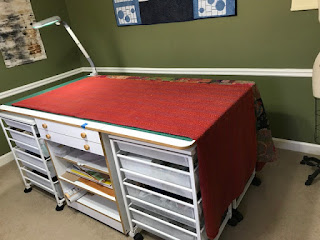It's a cold, cold day here. 14 degrees Fahrenheit this morning. So it's a good day to turn inward.
Speaking of turning in, it's high time I upgraded my sleepwear. For someone who makes almost all her own clothes, my PJs are shameful. Ripped t shirts purchased at the thrift store, old knit pants, and so on. So...
First up is this kimono constructed from an old favorite, folkwear pattern 112, Japanese Field Clothing. I've used the kimono pattern many times now, and the pants a few times. I like the clever pants construction that makes use of strictly rectangular fabric pieces. But I love the kimono pattern with its graceful simplicity.
The kimono is also made from rectangles - two sleeve rectangles, one front/back rectangle, and one long skinny rectangle for the front band/collar. There is almost no waste in cutting this out. The exception is the keyhole cut made to create a neckline.
I had barely enough of this wonderful linen piece to construct a size L men's kimono. In fact, you can see above where I had to piece the long skinny front band. I also had to use a light weight cotton fabric to face the sleeve hems and the main body hem.
I enjoy hand-finishing the raw edges of the seams, mostly while watching the news that is almost never enjoyable.
This linen was left over from a larger piece I purchased from a local designer who was cleaning out her stash several years ago. I made and wear a shirt out of it, also from a folkwear pattern, the Egyptian shirt. That too, is a very cool pattern. If you like making simple ethnic clothing, then folkwear is a great place to shop.
Another pattern from folkwear useful for PJs is what they call the Mexican dress. It is similar to those Mexican dresses many of us purchased for a song across the border in Texas during the 70's. I still have one of mine and this pattern is not exactly right. Someday I may redraft it to match mine.
This one is made from the cotton I used to face the kimono. It's a very light weight cotton with a dobby weave that I purchased from Vogue fabrics at a sewing expo. It is not a particularly fine piece of cloth but is soft and good for PJs.
The sleeves seem much larger in this pattern than they are in my old dress, but that's fine for my old wings, I think. They do kind-of stick out when I wear this so that I look like I might take flight.
The sleeves are quite lovely other than that. The underarm seam involves a Y seam that comes together perfectly.
It definitely needs some embroidery to look like the old-style Mexican dresses.
I also just completed a PJ set made with 2 Sewing Workshop patterns - the Eureka for the top and the Hudson for the pants. These are made from a super soft cotton knit that I purchased from the Martha Pullen booth at Expo.
It is sad that I did not purchase enough to make full length pants.
I hope you are finding time to create every day!


















































